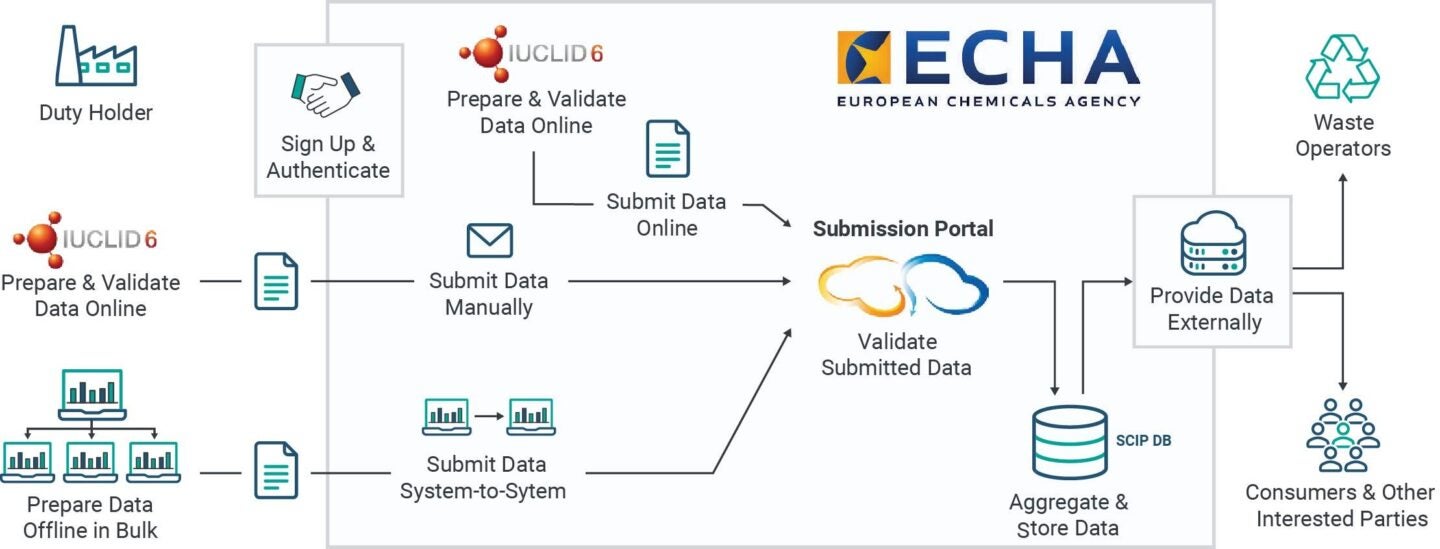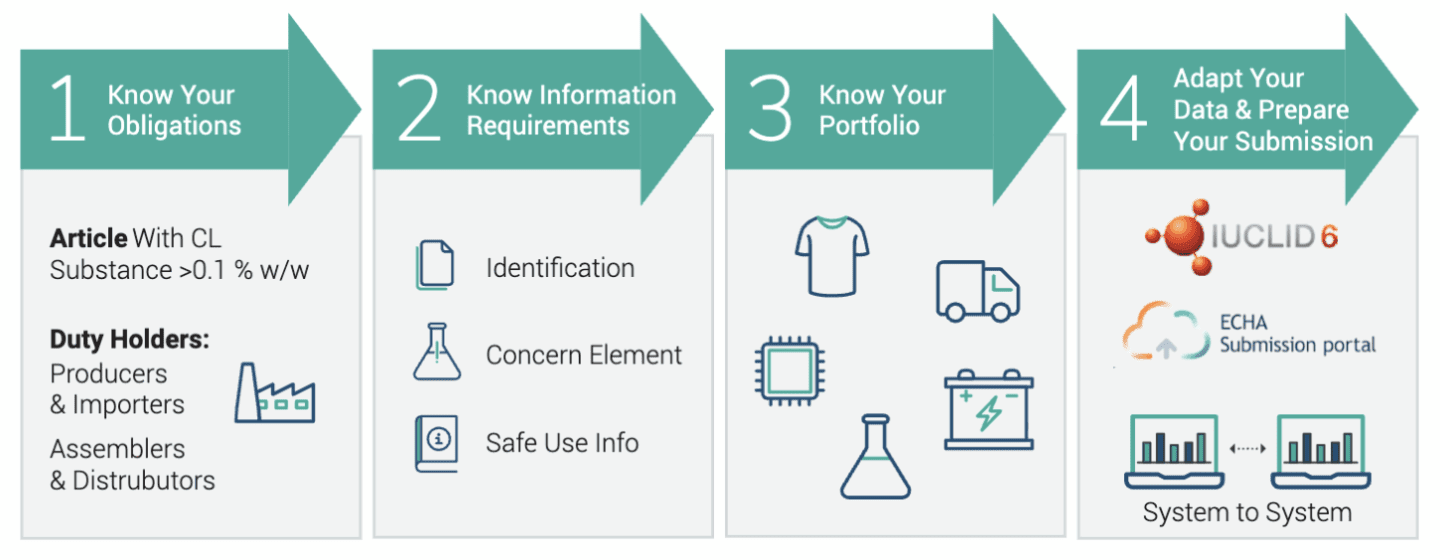The European Union is committed to building a circular economy — one in which products are designed for durability, reuse, and minimal waste. A key part of this vision is the EU Waste Framework Directive (WFD), updated in 2018, which introduced new requirements for tracking and managing substances of concern.
Under this directive, the European Chemicals Agency (ECHA) established the Substances of Concern In articles as such or in complex objects (Products) database, known as the SCIP database. This central database ensures that information on hazardous substances is available to waste operators, consumers, and authorities, improving transparency throughout a product’s lifecycle. (Check out our article covering what is the SCIP database for a quick introduction to your SCIP database requirements).
This article outlines ECHA’s data requirements for SCIP submissions, including key definitions, scoping guidance, and an example of how a compliant submission works in practice.
Looking for SCIP compliance software instead? You can learn more about our SCIP solution here.
The Scope of the EU SCIP Database Under the Waste Framework Directive
Understanding the scope of the EU Waste Framework Directive (WFD) and the SCIP database is essential for companies placing products on the EU market. ECHA provides precise definitions that determine which items require reporting.
Key Definitions: Articles, Complex Objects, Substances & Products
Articles & Complex Objects
Under the Registration, Evaluation, Authorisation, and Restriction of Chemicals (REACH) Regulation, an “article” is defined as an object that, during production, is given a special shape, surface, or design that determines its function more than its chemical composition. Articles can be combined to form complex objects — and per the Court of Justice of the European Union’s “Once an Article, Always an Article” ruling from 2015, each component remains an article even when assembled into a larger object.
For example, in a pencil sharpener, the plastic housing, the metal blade, and the screw attaching them are all articles within a single complex object.
Are You in Scope for EU Waste Framework Directive SCIP Reporting?
Any company manufacturing, assembling, importing, distributing, or selling materials or products in the EU that contain substances of very high concern (SVHCs) above the 0.1% weight-by-weight (w/w) threshold is in scope of the EU Waste Framework Directive and must submit data to the SCIP database.
Company Scope
While non-EU companies are not directly bound by the directive, they play an important role in compliance. To maintain EU market access, non-EU suppliers should provide complete and timely data to their European importing partners. In the EU, first importers carry the initial legal responsibility for submitting SCIP data on behalf of their non-EU suppliers.
The only exception applies to retailers or other supply chain actors that sell products directly and exclusively to end consumers.
Substances in Scope
Under the WFD, reporting the presence of hazardous substances into the SCIP database is mandatory. For each declared substance, companies must indicate its concentration range within the article:
- 0.1% w/w and < 0.3% w/w
- ≥ 0.3% w/w and < 1.0% w/w
- ≥ 1.0% w/w and < 10.0% w/w
- ≥ 10.0% w/w and < 20.0% w/w
- ≥ 20.0% w/w and < 100% w/w
- 0.1% w/w and ≤ 100% w/w
All products containing SVHCs above the threshold — in any variation — must be reported. Since the REACH Candidate List is updated roughly every six months, the SCIP database follows the same update cycle. Each time the Candidate List changes, companies should review product data and update their SCIP submissions accordingly.
How the SCIP Database Differs From the REACH Regulation
While the SCIP database and the REACH Regulation share similar goals, the reporting requirements under the EU Waste Framework Directive are more detailed and complex.
Key Differences in Data Reporting
SCIP submissions require declarations for materials and articles at every stage of manufacture and distribution across the supply chain. This means companies must provide a more granular breakdown of product composition compared to REACH.
Although many data points overlap, SCIP requires additional information beyond what is collected for REACH compliance.
| REACH | SCIP | DATA FOR SUBMISSION |
| EU REACH | REACH-IT Account | Legal Entity |
| Supplier Name | Article-Level Data | Article ID |
| Article Name | Chemical of Concern Data | More Data |
| SVHC Data | Substance Data (Reference Substance File) | Reference File (Core IUCLID) |
| Basic Safe Use Information | Create a Dossier File | Dossier ID |
| Submit Into ECHA Submission Portal | Submission ID |
Creating & Submitting an Article Record for the SCIP Database
The Three-Step Submission Process
Companies in scope of the EU WFD must submit the name, concentration range, and location of the substance in that article; information that allows for the identification of the article; and any other information stakeholders throughout the product life cycle will need for safe use.
Meeting SCIP database requirements involves three main steps:
- Create a REACH-IT account via the ECHA website.
- Create an article record containing all relevant identifying and composition details.
- Create and submit a SCIP dossier to the ECHA portal.
Each company will receive a REACH-IT account number, which can be used across the organization or assigned separately to each legal entity for efficiency.
Once a company has its REACH-IT account number, the next step in meeting SCIP database requirements is to create an article record. This record contains all the identifying information for an article and must be formatted according to the XSD specifications provided by the ECHA so it can be accepted by the International Uniform Chemical Information Database (IUCLID).
Mandatory vs. Optional Fields
Mandatory fields capture essential details for identifying the article, the substances it contains, and how it can be handled safely throughout its life cycle. Optional fields help stakeholders pinpoint the specific article containing the SVHC within a complex object — they should still be included if it represents a key identifier.
| Mandatory | Optional |
Article Name
|
|
Submission Methods
Companies can prepare and submit article records in three ways:
- Through the IUCLID online software hosted by the ECHA.
- Through the IUCLID offline software provided by the ECHA.
- Through a third-party, server-to-server SCIP compliance software solution.
The SCIP Dossier Submission Process for EU Waste Framework Directive Compliance
The final step in meeting SCIP database requirements is creating and submitting a SCIP dossier. This dossier consolidates all article data and ensures that hazardous substances are documented for regulatory authorities, waste operators, and the public.
Which Data Is Required in a SCIP Dossier?
- Name
- Version
- Dossier Name
- Submitting Legal Entity
- Dossier Creation Date & Time
- Dossier ID

Key Submission Steps
To track products and update submissions when new substances of very high concern (SVHCs) are added to the REACH Candidate List, companies need two critical identifiers:
- Legal Entity ID: Generated when an EU company registers a REACH-IT account. This identifies the company submitting the data to ECHA.
- Article Number: Identifies each individual product or component containing SVHCs above the 0.1% w/w threshold.
Once submitted through the ECHA SCIP portal, the system generates all necessary identifiers, including article ID, legal entity ID, dossier ID, and submission ID.
Example of a SCIP Database Submission
To help companies understand SCIP database requirements, ECHA provides example declarations showing how article information should be reported. One such example details the submission process for a simple article — an O-ring.
This example demonstrates the level of detail and accuracy required for SCIP submissions, ensuring that hazardous substances are traceable throughout a product’s life cycle.

Material Categories & Safe Use Information for SCIP Database Submissions
When submitting data to the SCIP database under the EU Waste Framework Directive, companies must classify the materials used in their articles. This improves transparency for waste operators, recycling facilities, and other stakeholders throughout a product’s life cycle.
Material Category Requirements
ECHA has identified 11 primary material categories, each with tiered subcategories. Companies must declare the category and at least the first subcategory. The second subcategory is optional unless readily available.
The 11 categories are:
- Ceramics
- Glass
- Leather and rawhides
- Metals
- Paper and board
- Plastics (and polymers)
- Rubbers and elastomers
- Stone, plaster, and cement
- Textile fibers and other fibers
- Wood and cork
- Other
Example: A company producing pencil sharpener blades would report:
- Category (Level 1): Metal
- Subcategory (Level 2): Steel
- Subcategory (Level 3): Stainless steel
For composite materials, companies must list the appropriate category and subcategory for each distinct material used.
Safe Use Information
Submissions must also include safe use information for each stakeholder group, including consumers, professional or industrial end users, service operators, and waste operators. The goal is to provide enough detail to support risk management and ensure safe handling.
Initially, companies can indicate that no additional safe use information is needed beyond the identification of the substance. However, ECHA is expected to develop a harmonized list of safe use statements for consistent reporting.
Optional details can include disassembly instructions or supplementary documents to assist waste operators in handling the product responsibly.
Data Collection Best Practices for SCIP Database Reporting
Collecting the detailed information required for SCIP database submissions under the EU Waste Framework Directive can be challenging. Proactive planning and structured data management make the process more efficient and ensure compliance.
Recommended Steps From ECHA
ECHA advises companies to follow a systematic approach:

- Know Your Obligations: Understand your legal requirements under the EU WFD and SCIP database rules.
- Know the Information Requirements: Familiarize yourself with the XSD structure provided by ECHA to identify exactly what data you need.
- Know Your Portfolio: Map your products and identify where substances of very high concern (SVHCs) exist.
- Adapt Your Data and Prepare Your Submission: Organize and format your data to meet SCIP specifications, then submit it using your chosen method (online, offline, or through third-party software).
Companies already reporting on SVHCs under REACH can leverage existing data as a foundation, then add the extra fields required for SCIP compliance. In some cases, additional testing of articles may be necessary to verify material composition.
Ensuring Ongoing Compliance With the EU Waste Framework Directive & SCIP Database
Meeting SCIP database requirements under the EU WFD is not a one-time task — it requires ongoing data management and supplier engagement. Companies must have a comprehensive strategy for collecting, maintaining, and updating compliance information as regulations and the REACH Candidate List evolve.
The Role of Supplier Communication
Clear and proactive communication with suppliers ensures the timely flow of accurate data. This is especially important when sourcing from non-EU suppliers, who may not be directly obligated under the WFD but whose cooperation is essential for EU market access.
Leveraging Technology for Compliance
A SCIP compliance software solution can streamline supplier engagement, automate data tracking, and simplify submission workflows. With centralized data management, companies can more easily identify risks, avoid missed deadlines, and respond quickly to regulatory changes.
Assent’s SCIP compliance software streamlines every step of the submission process you’ve just read about — from collecting supplier data and classifying materials to creating complete, accurate dossiers for the ECHA SCIP database. By automating data gathering, ensuring alignment with the latest EU Waste Framework Directive requirements, and simplifying communication with suppliers, Assent helps you reduce the risk of errors, missed deadlines, and regulatory penalties. With greater visibility into your supply chain and ongoing support as regulations evolve, you can move from reactive compliance to proactive risk management.
FAQ: SCIP Database Requirements
Get answers to the most common SCIP database and WFD compliance questions from our experts.



